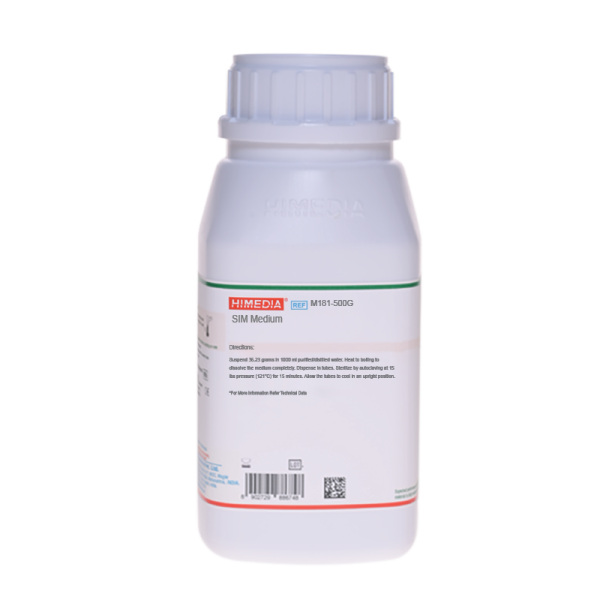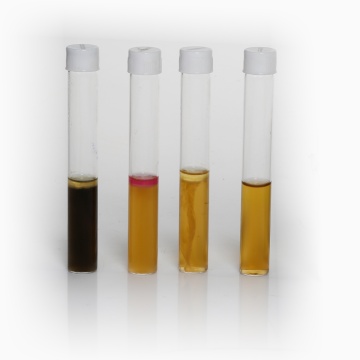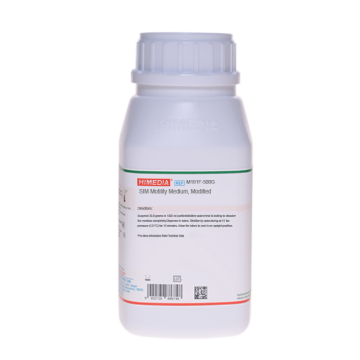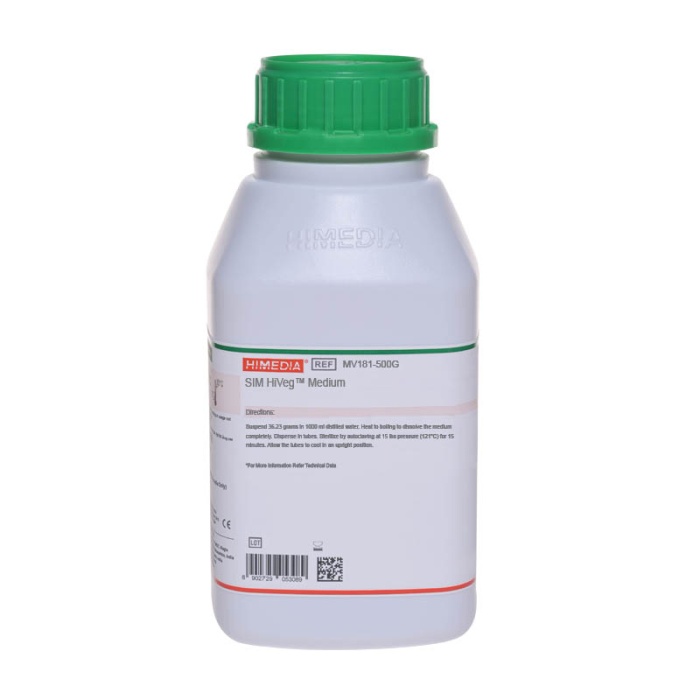 Your enquiry has been submitted
Your enquiry has been submitted
SIM Medium
Intended use
Recommended for determination of hydrogen sulphide production, indole formation and motility of enteric bacilli from clinical and non-clinical samples.
Composition**
| Ingredients | Gms / Litre |
|---|---|
| HM Peptone B# | 3.000 |
| Peptone | 30.000 |
| Peptonized iron | 0.200 |
| Sodium thiosulphate | 0.025 |
| Agar | 3.000 |
Final pH ( at 25°C): 7.3±0.2
**Formula adjusted, standardized to suit performance parameters
# - Equivalent to Beef extract
Directions
Suspend 36.23 grams in 1000 ml purified/ distilled water. Heat to boiling to dissolve the medium completely. Dispense in tubes. Sterilize by autoclaving at 15 lbs pressure (121°C) for 15 minutes. Allow the tubes to cool in an upright position.
Principle And Interpretation
SIM Medium is used to differentiate enteric bacilli particularly Salmonella and Shigella on the basis of sulphide production, indole formation and motility (1,5). Jordan and Victorson (3) reported that Salmonella Paratyphi A and Paratyphi B can be distinguished on the basis of H2S production using lead acetate. Sulkin and Willett (7) used Triple Sugar Iron Agar with 1% agar for motility along with H2S production and carbohydrate fermentation. Sosa (6) described a peptone medium with low agar for motility and indole determination.
SIM Medium enables determination of three characteristics by which enteric bacteria can be differentiated. Peptonized iron and sodium thiosulphate are the indicators of H2S production. This H2S reacts with peptonized iron to form black precipitate of ferrous sulphide (6,7). Motile organisms intensify the H2S reaction. Motile organisms grow away from line of inoculation showing diffused growth while non-motile organisms grow along the stab line. Motility detection is possible due to the semisolid nature of the medium. Growth radiating out from the central stab line indicates that the test organism is motile. Peptone and HM peptone B provides nitrogenous and carbonaceous compounds, long chain amino acids, vitamins and other essential nutrients. Tryptophan from peptone, is degraded by specific bacteria to produce indole (1). The indole is detected by the addition of chemical reagents following the incubation period.
Inoculate fresh culture with a single stab using straight needle through the center of the medium. Following incubation, observe for motility (diffuse growth outward from the stab line or turbidity throughout the medium) and for H2S production (blackening of the medium). To detect indole production, add three or four drops of Kovacs reagent (1) and observe for development of red color (positive reaction). Determine motility and H2S production prior to determination of indole production.
Type of specimen
Isolated Microorganisms
Specimen Collection and Handling
After use, contaminated materials must be sterilized by autoclaving before discarding.
Warning and Precautions
Read the label before opening the container. Wear protective gloves/protective clothing/eye protection/ face protection. Follow good microbiological lab practices while handling specimens and culture. Standard precautions as per established guidelines should be followed while handling specimens. Safety guidelines may be referred in individual safety data sheets.
Limitations
- This medium is general purpose medium and may not support the growth of fastidious organisms.
Performance and Evaluation
Performance of the medium is expected when used as per the direction on the label within the expiry period when stored at recommended temperature.
Quality Control
Appearance Cream to beige homogeneous free flowing powder
Gelling Semisolid, comparable with 0.3% Agar gel.
Colour and Clarity of prepared medium Medium amber coloured slightly opalescent gel forms in tubes as butts
Reaction Reaction of 3.6% w/v aqueous solution at 25°C. pH : 7.3±0.2
pH 7.10-7.50
Cultural Response Cultural characteristics observed after an incubation at 35-37°C for 18-24 hours.
| Organism | Inoculum (CFU) | Growth | Motility | Indole production (on addition of Kovac's) | H2S |
|---|---|---|---|---|---|
| Escherichia coli ATCC 25922 (00013*) | 50-100 | luxuriant | positive, growth away from stabline causing turbidity | positive reaction, red ring at the interface of the medium | negative reaction |
| Salmonella Typhimurium ATCC 14028 (00031*) | 50-100 | luxuriant | positive, growth away from stabline causing turbidity | negative reaction | positive reaction, blackening of medium |
| Shigella flexneri ATCC 12022 (00126*) | 50-100 | luxuriant | negative, growth along the stabline, surrounding medium remains clear | negative reaction | negative reaction |
| Salmonella Paratyphi A ATCC 9150 | 50-100 | luxuriant | positive, growth away from stabline causing turbidity | negative reaction | Negative reaction |
| Salmonella Paratyphi B ATCC 8739 | 50-100 | luxuriant | positive, growth away from stabline causing turbidity | Negative reaction | Positive reaction, blackening of medium |
| Klebsiella pneumoniae ATCC 13883 (00097*) | 50-100 | luxuriant | negative, growth along the stabline, surrounding medium remains clear | Negative reaction | Negative reaction |
Key : *Corresponding WDCM numbers.
Storage and Shelf Life
Store between 10-30°C in a tightly closed container and the prepared medium at 2-8°C. Use before expiry date on the label. On opening, product should be properly stored dry, after tightly capping the bottle in order to prevent lump formation due to the hygroscopic nature of the product. Improper storage of the product may lead to lump formation. Store in dry ventilated area protected from extremes of temperature and sources of ignition Seal the container tightly after use. Use before expiry date on the label.
Product performance is best if used within stated expiry period.
Disposal
User must ensure safe disposal by autoclaving and/or incineration of used or unusable preparations of this product. Follow established laboratory procedures in disposing of infectious materials and material that comes into contact with clinical sample must be decontaminated and disposed of in accordance with current laboratory techniques (2,4).
Reference
- Ewing W. H., 1986, Edwards and Ewings Identification of Enterobacteriaceae, 4th Ed., Elsevier Science Publishing Co., Inc. New York.
- Isenberg, H.D. Clinical Microbiology Procedures Handbook. 2nd Edition.
- Jordan E. O. and Victorson R., 1917, J. Inf. Dis., 21:554.
- Jorgensen, J.H., Pfaller , M.A., Carroll, K.C., Funke, G., Landry, M.L., Richter, S.S and Warnock., D.W. (2015) Manual of Clinical Microbiology, 11th Edition. Vol. 1.
- MacFaddin J. F., 1985, Media for Isolation-Cultivation-Identification-Maintenance of Medical Bacteria, Vol. 1, Williams and Wilkins, Baltimore.
- Sosa L., 1943, Rev. Inst. Bacteriol., 11:286.
- Sulkin S. E. and Willett J. C., 1940, J. Lab. Clin. Med., 25:649.
| Product Name | SIM Medium |
|---|---|
| SKU | M181 |
| Product Type | Regular |
| Physical Form | Powder |
| Origin | Animal |
| Packaging type | HDPE |
| References | 1. MacFaddin J. F., 1985, Media for Isolation-Cultivation-Identification-Maintenance of Medical Bacteria, Vol. 1, Williamsand Wilkins, Baltimore. 2.Ewing W. H., 1986, Edwards and Ewings Identification of Enterobacteriaceae, 4th Ed., Elsevier Science Publishing Co.,Inc. New York. 3.Jordan E. O. and Victorson R., 1917, J. Inf. Dis., 21:554. 4.Sulkin S. E. and Willett J. C., 1940, J. Lab. Clin. Med., 25:649. 5.Sosa L., 1943, Rev. Inst. Bacteriol., 11:286. 6.Isenberg, H.D. Clinical Microbiology Procedures Handb0ook. 2nd Edition. 7.Jorgensen,J.H., Pfaller , M.A., Carroll, K.C., Funke, G., Landry, M.L., Richter, S.S and Warnock., D.W. (2015)Manual of Clinical Microbiology, 11th Edition. Vol. 1. |
| Customized Product Available | No |











